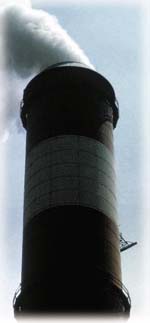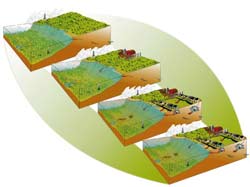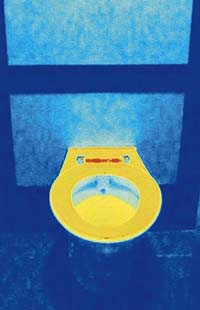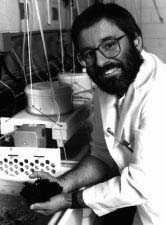
![]()
Volume 6, No. 2
Promoting Cooperation to Maintain and Enhance
Environmental Quality in the Gulf of Maine
|
||||||||||
|
Regular columns |
|
Archives |
|
About |
The environmental disruption caused by an overload of nitrogen is emerging as a new concern for the Gulf of Maine
By Andi Rierden, Editor
And therein lies the rub. Behind nitrogen's amazing ability to stimulate growth dwells the reason for the havoc it can cause. Among the disturbing findings, science has established that an excess of chemically "fixed" nitrogen is harming and altering ecosystems by making plants poorly equipped to cope with nitrogen-rich environments disappear.
World-wide, the major sources of excess nitrogen are many and varied, including industrial processes that produce nitrogen fertilizers, the burning of fossil fuels in automobiles and power plants, and the clearing of forests and draining of wetlands, which free nitrogen from long-term storage in soil and tree trunks. Run-off from farm fields, wastewater treatment plants, faulty septic systems and fish wastes from aquaculture operations also add to the nitrogen glut.
In marine and coastal systems, nitrogen is the main ingredient that kick-starts a sequence of ecological impacts called eutrophication. The condition occurs when a surfeit of nitrogen promotes an extensive growth of phytoplankton and seaweed, or macroalgae. While they live, these organisms can cloud the water, blocking sunlight to plants and other marine life. When they die, they are consumed by bacteria, which proliferate and deplete the water of oxygen. By depriving and smothering life within an aquatic system, eutrophication ultimately lowers biodiversity.
On the home front
In the Gulf of Maine region, symptoms are perhaps most acute in areas of coastal Massachusetts, particularly in southern parts of Cape Cod, where studies have linked the decline of eelgrass, an important habitat for fish and shellfish, to nitrogen enrichment of the region's bays. Says Andrew Gottlieb, assistant commissioner for Policy and Planning for the Massachusetts Department of Environmental Protection: "We're experiencing significant degradation in some embayments. They're over eutrophied, dominated by blue green and brown algae and we've had fish kills."
There are uncertainties and gaps in data, and much is unclear about the wide-ranging effects of excess nitrogen in the Gulf or whether it has increased or decreased. Data collected by the National Oceanic and Atmospheric Administration (NOAA), satellite imagery, scientific cruises and some monitoring have contributed preliminary information to show areas in the Gulf considered most susceptible to eutrophication. But experts across the region say much more research, monitoring and management are critical in determining what embayments may be impaired or at risk, particularly as development along the coast spreads and activities like finfish aquaculture expand.
A recent workshop report by the University of New Hampshire's Cooperative Institute for Coastal and Estuarine Environmental Technology (CICEET), NOAA and the Gulf of Maine Council on the Marine Environment, calls for a Gulf-wide plan to help local and regional communities determine the degree and severity of nitrogen in their coastal embayments. Researchers who contributed to the report say resource managers and regulators need a model to calibrate and compare nitrogen impacts throughout the Gulf, taking into account measures like an embayment's population density, tidal conditions and sources of nitrogen input.
"Not everybody in the Gulf of Maine needs to be concerned, but they should be aware [of nitrogen problems]," says Richard Langan the UNH director of CICEET, and workshop organizer. "As development of the coast continues to expand we need to give people a heads up, so they can get a handle on any of the impacts."
A natural source
One thing scientists know for certain, the vast majority of nitrogen circulating in the Gulf of Maine is natural and comes from the open ocean. Whether the nitrogen-rich ocean water will cause problems once winds, currents or other conditions carry it inshore is a question of scale, says Dr. David Townsend, an oceanographer at the University of Maine. Nitrogen entering a well-flushed estuary may quickly disperse to the open sea and contribute little to eutrophication. On the other hand, a poorly-flushed embayment may retain its nitrogen load long enough to stimulate eutrophication and knock the system out of whack. If the water hangs around, Townsend says, more nutrients accumulate creating a higher potential for algae blooms and oxygen depletion. The size of the estuary or embayment also influences the concentration of nitrogen once it enters the watershed.
"The level of contaminants or human impacts becomes significant the smaller the body of water and the closer the source of those nutrients, which is the shoreline," he says.
Townsend and other scientists have established that Alexandrium fundyense, the algae that causes red tides, grows in healthy, nitrogen-rich waters offshore in the Gulf of Maine. But when red tides are blown inshore, the toxin omitted by the algae can contaminate clams and mussels with paralytic shellfish poisoning-putting them off limits to human consumption. Coastal waters polluted by excess nitrogen can exacerbate these blooms, or mimic conditions that work well for Alexandrium offshore. Because of certain factors including population size, some harbors and bays are more susceptible to promoting red tides.
Says Townsend: "99.99 percent of the Alexandrium population in the Gulf of Maine is natural and occurs offshore, but the 0.01 percent you will find in [coastal areas] seem to have local populations that are stimulated by [human generated] nutrients."
A natural cycle gone awry
Before humans began altering the nitrogen cycle with synthetic compounds, these natural processes fixed from 90 million to 150 million metric tons of nitrogen a year according to the Ecological Society of America. Today, human activity adds 132 million to 153 million metric tons annually. Chemically altered nitrogen molecules, commonly known as "reactive nitrogen," then cycle from one polluting form to another. For example, nitric acid is a chief element in acid rain, nitrates and other compounds in waterways are blamed for depleting coastal waters of oxygen, while nitrogen oxides form soot and smog and threaten respiratory health.
Atmospheric nitrogen
Next to natural nitrogen, atmospheric nitrogen from smokestacks, cars and trucks, is the largest source in the Gulf of Maine, according to the CICEET report. The effects are as far-reaching as Acadia National Park in Maine where summer ozone levels have occasionally exceeded federal health standards. Around the Bay of Fundy, southern New Brunswick and parts of Nova Scotia southwest of Halifax, 50 to 80 percent of the smog is caused by cross-border pollution from the northeastern United States or emissions from central Canada.
Controlling the problem is, in part, out of the hands of local and regional communities and depends on federal and international regulatory strategies. On a positive note, scientists say the amount of atmospheric nitrogen in the Gulf appears to have stabilized. They further estimate that tougher automobile emissions controls in the United States and Canada will help decrease atmospheric deposits of nitrogen oxides. The new controls for both countries will go into effect next year.
In April, New Hampshire passed legislation aimed at reducing emissions of nitrogen oxide and three other pollutants from the state's fossil fuel burning power plants. The Clean Power Act makes New Hampshire the first state to legislate a reduction in common pollutants from power plants. By 2007, nitrogen oxide emissions must be cut by 70 percent, which will reduce this pollution to 90 percent lower than 1990 levels.
"With this legislation, New Hampshire is sending a powerful message to other states and the federal government," Governor Jeanne Shaheen said in a press release. "Pollution does not respect state boundaries. Other states and the federal government must follow our lead so that downwind states like New Hampshire have clean air."
Wasted away
Then there's the unpleasant issue of waste. One of the Gulf of Maine's biggest headaches is the excess of nitrogen spewing into waterways from wastewater treatment plants and septic systems. According to a NOAA inventory of land-based pollution sources to the Gulf of Maine published in 1994, about 91 percent of all point source nitrogen discharges-those originating from a concentrated source with a specific point of release-come from wastewater.
Some 300 billion gallons of effluent from at least 378 wastewater treatment plants are discharged each year into the Gulf's watershed, according to a 1998 survey by the Global Programme of Action Coalition for the Gulf of Maine. Yet few facilities treat sewage for nutrients, like nitrogen. Typically, sewage treatment in the Gulf watershed uses a preliminary process to break down the solids, followed by a secondary level of treatment to break down organic matter. The problem is, secondary treatment of sewage effluent removes only about 25 percent of the nitrogen. Advanced treatment to remove the compound is expensive and rarely applied in the Gulf region. In general, states, provinces or municipalities regulate whether an industrial or wastewater treatment plant requires advanced treatment.
Other wastewater challenges include underdesigned sewer systems found mainly in older urban areas and built to collect rainwater runoff, domestic sewage and industrial wastewater in the same pipe. During periods of heavy rainfall or snow melt, the wastewater volume in a combined sewer system can exceed the capacity of the main treatment plant. The U.S. Environmental Protection Agency estimates that after a heavy precipitation event, hundreds of millions of gallons of untreated sewage and stormwater are discharged into New England waterways from overflow pipes. A few urban centers are slowly upgrading treatment systems and removing the old pipes, though at a high cost.
In Massachusetts, the Massachusetts Water Resource Authority's $2 billion wastewater system has diverted much of the wastewater that used to flow to the combined sewage and stormwater pipes and into the Boston Harbor to the Deer Island sewage treatment plant. As a result, the number of beach closures in the harbor has decreased.
Finfish aquaculture
Among other concerns is the impact of nitrogen loads coming from aquaculture farms. In 2000, more than 100 million pounds of finfish were grown in the Gulf of Maine. New Brunswick produced 66 million pounds, followed by Maine at 36 million pounds, with 1 million generated between Massachusetts, Nova Scotia and New Hampshire. John Sowles of Maine's Department of Marine Resources (DMR) has found that finfish aquaculture increases the amount of nitrogen in Cobscook Bay by ten percent. However, his research has not shown that aquaculture in the Bay creates adverse impacts to water quality or habitats.
"You don't see the effects because the nutrients are flushed out," he says. "Where we're concerned is when you move west along the southern coast of Maine into these long bays and inlets that don't flush and have longer resident times. That's why we're concerned with Blue Hill Bay."
Yet even in well-flushed regions of the Gulf, nitrogen wastes from aquaculture operations are an ongoing concern. "Any bay can carry only so much activity," says Dr. Thierry Chopin of the University of New Brunswick's Centre for Coastal Studies and Aquaculture. "The problem is, nobody knows exactly what this carrying capacity is, which, moreover, can vary from bay to bay."
Despite the vigorous tidal action of the Bay of Fundy, Chopin adds, the effects of excess nitrogen can take its toll. "The myth is that the Bay can handle the excess, but there is not as much flushing as people think. The water goes in and it goes out, but like a big bathtub, it's the same water. And studies have shown that it takes 76 days to exchange all that."
Dr. Peter Strain, a marine chemist with Canada's Department of Fisheries and Oceans, has been studying the impact of nutrients and organic wastes discharged into coastal inlets, and the susceptibility of an inlet to eutrophication. In one study of the Letang Inlet in southern New Brunswick, where there is a large concentration of fish farms, Strain found aquaculture to be the single largest contributor of nitrogen. Some of the possible impacts of the excess nutrients, Strain says, include more extensive mats of nuisance intertidal algae. "There certainly have been anecdotal reports [of more algae mats] and we're trying to quantify that to see if that is true," he says.
Trying to nail down the effects of aquaculture in the open waters of the Bay is more of a challenge because of tidal action, Strain adds. "Certainly we see changes very close to fish farms or areas like the Letang but once you move a little offshore, the effects are much more subtle and more difficult to identify."
The bottom line, say researchers, is that nitrogen in the Gulf of Maine is coming predominantly from the ocean and from reactive compounds in the atmosphere, but that additional human inputs of nitrogen can easily tip the balance and wreak havoc within local embayments.
"If you go into a bay the main source may be septic tanks of individual property owners. In another bay it might be a sewage treatment plant, and in another bay it might be aquaculture," Sowles of Maine's DMR says. "Theoretically we could be improving these bays as long as people take the issue seriously. Otherwise problems are going to increase."
A copy of the CICEET report Managing Nitrogen Impacts in the Gulf of Maine is available at: http://gulfofmaine.org/council/monitoring.shtml. By Andi Rierden
The innovations range
from units with modifications in leach trench design to improve soil absorption, those involving
recirculating sand filters, and small plants containing aerobic biofilters that spray effluent over a
foam media. Rigorous testing has shown that some systems can remove twice as much nitrogen as a state-
approved system, which removes only 22 to 25 percent of nitrogen.
I think the better
option for a community is to use these systems to supply more than one house. By code they have to be
inspected four to five times a year, which will run an individual homeowner about $400 to $500 plus
electricity to run them. But if you cluster them you cut your costs to about $120 a year.
About 300
homes on Cape Cod have installed the alternative systems, he says, but the problem is, many are not
being monitored or watched properly.
Heufelder, who is also the environmental program manager with the
Barnstable County Department of Health and the Environment, says county officials are trying to convince
towns to develop comprehensive management programs to inspect, maintain and monitor the alternative
systems.
With vigilant maintenance the units will perform properly, more models will be produced and the
costs of these systems may decline, he predicts. But the clock is ticking. Massachusetts has committed
$12 million to identify nitrogen sensitive embayments. Once that is completed and total daily maximum
nitrogen loads are determined, Heufelder says, We’re going to have to say, ‘Okay in this watershed we’ve
got 600 homes and we have to get rid of X amount of nitrogen.’ Right now we only have two solutions:
build another treatment plant or have everybody do it onsite.
To safeguard ground and coastal waters for
the long-term, he says, more cost-wise innovations and flexible thinking are critical. We need more
things in our toolbox, we need different sized hammers and screwdrivers, and if we don’t have them by
the time we identify these nitrogen sensitive embayments, we’re not going to have the tools to fix them.
The practice of growing different species of seaweeds, shellfish and fish in close proximity is referred to as integrated aquaculture or polyculture, and is nothing new. "The Asian countries have been doing it for centuries," Chopin says.
He adds that with the low price of salmon, aquaculturists cannot afford to bypass polyculture's environmental and economic benefits. "By turning the wastes of one resource user into fertilizer or food for the other," Chopin says, "we contribute both to bioremediation and diversification of the aquaculture industry.
As a fertilizer for lawns, gardens or farm fields, nitrogen has long been thought of as mostly benign and beneficial. The element occurs naturally and is essential to plant growth, and thus to animal growth. A common chemical in living tissues, nitrogen is a component of amino acids, the building blocks of protein. As a manufactured fertilizer, the compound has made modern-day agriculture possible. It is so useful, in fact, that human beings have more than doubled the amount of nitrogen naturally available to the Earth's ecosystems over the past century.

Nitric oxides from smokestacks and other sources are a main contributor of excess nitrogen in the Gulf of Maine region. Above: power plant plume over Piscataqua River Bridge in New Hampshire.
Photo: Daryl Ann Hurst
In its natural state, nitrogen is abundant. More plentiful than oxygen, nearly 80 percent of the atmosphere is nitrogen gas. But plants cannot absorb it until it becomes fixed-bonded with hydrogen or oxygen-to form into biologically useful nitrogen compounds. In nature, there are two ways this happens: a few specialized algae and soil bacteria contain enzymes that enable them to convert the nitrogen into useable form, and lightning transforms the gas into nitrates, which then rain into soil and water.

Design by Jeff Hughes, Linda Deegan and Jim Kremer of the Ecosystem Center.
This model, created by a team of scientists and educators at the Ecosystem Center, Marine Biological Laboratory, Woods Hole, MA, illustrates the ever-increasing load of nitrogen into an estuary caused by the surge of suburban development. The arrows represent nitrogen sources from the atmosphere, fertilizer run-off from lawns, golf courses, agriculture, wastewater treatment plants, on-site septic systems and impervious surfaces. For more detailed graphics and explanations go to www.ecosystems.mbl.edu/Research/Clue/.
Alternative septic
systems to the rescue
 On Cape Cod where 90 percent of homes have on-site septic systems, degradation of coastal embayments
from nitrogen has become a serious problem. Conventional septic systems primarily remove bacteria from
the decay of organic wastes, yet do little to remove nitrogen. In recent years more alternative systems
with a greater capacity to remove nitrogen have become commercially available thanks to the
Massachusetts Septic System Test Center. Started in 1999 as a collaborative project between the Buzzards
Bay Project National Estuary Program and state and local agencies, the center is a testing ground for
alternative septic systems suited for individual homes or cluster developments.
On Cape Cod where 90 percent of homes have on-site septic systems, degradation of coastal embayments
from nitrogen has become a serious problem. Conventional septic systems primarily remove bacteria from
the decay of organic wastes, yet do little to remove nitrogen. In recent years more alternative systems
with a greater capacity to remove nitrogen have become commercially available thanks to the
Massachusetts Septic System Test Center. Started in 1999 as a collaborative project between the Buzzards
Bay Project National Estuary Program and state and local agencies, the center is a testing ground for
alternative septic systems suited for individual homes or cluster developments.
Depending on location, lot size and
soil conditions a conventional system in Massachusetts ranges from $8,000 to $16,000 or more. The
alternative systems can cost from $5,000 and up to $10,000, says George Heufelder, operations manager
for the test center. Because denitrification models require more maintenance and oversight than standard
systems, he adds, they are more ideal for small developments of five to 15 homes.
 Estuaries function as nutrient and particle
traps, recycling nitrogen through repeated
processes of growth and decay.
Photo: Daryl-Ann Hurst
Estuaries function as nutrient and particle
traps, recycling nitrogen through repeated
processes of growth and decay.
Photo: Daryl-Ann Hurst
Sustainable aquaculture?
Dr. Thierry Chopin of the University of New Brunswick's Centre for Coastal Studies and Aquaculture wants to turn nitrogen-rich fish effluent into gold. In the waters near St. Andrews, New Brunswick, Chopin and his colleagues are employing an age-old farming method that integrates Atlantic salmon with blue mussels and kelp. The idea is to convert the nutrients coming from the fish waste and food into mussel meat and seaweed tissues of commercial value. Chopin explains that the seaweed and mussels act as a scrubbing system, absorbing the nitrogen, which helps to maintain a balanced ecosystem. Mussels grow faster when grown around finfish, he adds, and the introduced seaweed also serves as a competitor. "If I cultivate desirable seaweeds like kelp, there should be proportionally less nutrients for the undesirable ones, like those in the fuzzy brown and green mats," he says.

Dr. Thierry Chopin wants to spin nitrogen
(and phosphorous) into gold.
Photo: Oak Tree Photography